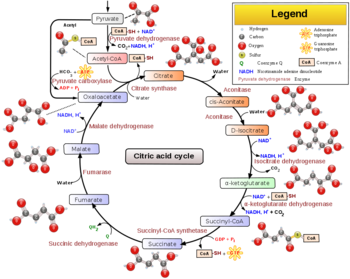Citric Acid Cycle
From Proteopedia
(Difference between revisions)
| Line 8: | Line 8: | ||
The [[Citric Acid Cycle]] (tricarboxylic acid cycle) is a series of enzyme catalyzed reactions which are critical in cellular respiration. Under oxidative conditions, pyruvate continues to be metabolized through the tricarboxylic acid cycle. In this cycle, Acetyl-CoA, a byproduct of [[glycolysis]], along with various cofactors, are broken down into carbon dioxide, water, and energy in the form of GTP and NADH. | The [[Citric Acid Cycle]] (tricarboxylic acid cycle) is a series of enzyme catalyzed reactions which are critical in cellular respiration. Under oxidative conditions, pyruvate continues to be metabolized through the tricarboxylic acid cycle. In this cycle, Acetyl-CoA, a byproduct of [[glycolysis]], along with various cofactors, are broken down into carbon dioxide, water, and energy in the form of GTP and NADH. | ||
| - | [[Pyruvate dehydrogenase]] | + | '''Pyruvate decarboxylation or pyruvate oxidation''', also known as the link reaction (or oxidative decarboxylation of pyruvate), is the conversion of pyruvate into Acetyl-CoA by the enzyme complex pyruvate dehydrogenase complex (see [[Pyruvate dehydrogenase]]). |
| - | The multienzyme complex together catalyzes five distinct reactions in the conversion of pyruvate to | + | The multienzyme complex together catalyzes five distinct reactions in the conversion of pyruvate to Acetyl-CoA. The overall result is described by the following reaction: |
Pyruvate + CoA + NAD+ ==> Acetyl-CoA + CO2 + NADH | Pyruvate + CoA + NAD+ ==> Acetyl-CoA + CO2 + NADH | ||
Revision as of 10:37, 15 September 2022
Proteopedia Page Contributors and Editors (what is this?)
Alexander Berchansky, David Canner, Ann Taylor, Wayne Decatur, Jaime Prilusky

